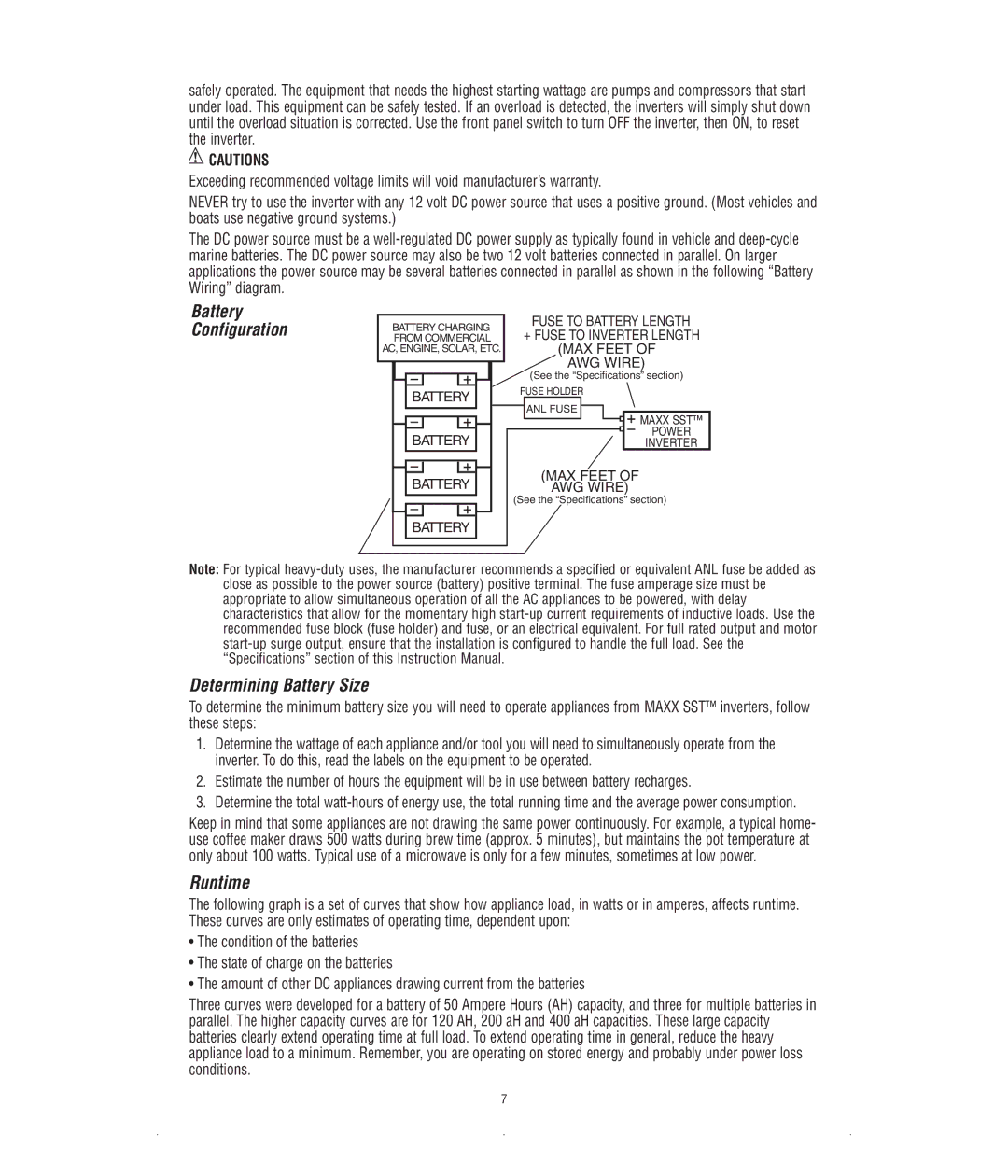
safely operated. The equipment that needs the highest starting wattage are pumps and compressors that start under load. This equipment can be safely tested. If an overload is detected, the inverters will simply shut down until the overload situation is corrected. Use the front panel switch to turn OFF the inverter, then ON, to reset the inverter.
![]() CAUTIONS
CAUTIONS
Exceeding recommended voltage limits will void manufacturer’s warranty.
NEVER try to use the inverter with any 12 volt DC power source that uses a positive ground. (Most vehicles and boats use negative ground systems.)
The DC power source must be a
Battery Configuration
| BATTERY CHARGING |
| FUSE TO BATTERY LENGTH | |||||||||||||
|
| + FUSE TO INVERTER LENGTH | ||||||||||||||
| FROM COMMERCIAL |
| ||||||||||||||
AC, ENGINE, SOLAR, ETC. |
|
| (MAX FEET OF | |||||||||||||
|
|
|
|
|
|
|
|
|
| AWG WIRE) | ||||||
|
|
|
|
|
|
|
| |||||||||
|
|
|
|
|
|
|
|
| (See the “Specifications” section) | |||||||
|
| BATTERY |
|
| FUSE HOLDER | |||||||||||
|
|
|
|
| ANL FUSE |
|
|
|
|
|
| |||||
|
|
|
|
|
|
|
|
|
|
|
|
|
|
| ||
|
|
|
|
|
|
|
| |||||||||
|
|
|
|
|
|
|
|
|
|
|
|
|
|
|
| MAXX SST™ |
|
|
|
|
|
|
|
|
|
|
|
|
|
|
|
| POWER |
|
| BATTERY |
|
| ||||||||||||
|
|
|
|
|
|
|
|
|
|
|
| INVERTER | ||||
|
|
|
|
|
|
|
|
|
| (MAX FEET | OF | |||||
|
| BATTERY |
|
|
|
| ||||||||||
|
|
|
|
|
| AWG WIRE) | ||||||||||
|
|
|
|
|
|
|
| (See the “Specifications” section) | ||||||||
|
| BATTERY |
|
|
|
|
|
|
|
|
|
|
| |||
|
|
|
|
|
|
|
|
|
|
|
|
|
|
|
|
|
|
|
|
|
|
|
|
|
|
|
|
|
|
|
|
|
|
Note: For typical
Determining Battery Size
To determine the minimum battery size you will need to operate appliances from MAXX SST™ inverters, follow these steps:
1.Determine the wattage of each appliance and/or tool you will need to simultaneously operate from the inverter. To do this, read the labels on the equipment to be operated.
2.Estimate the number of hours the equipment will be in use between battery recharges.
3.Determine the total
Keep in mind that some appliances are not drawing the same power continuously. For example, a typical home- use coffee maker draws 500 watts during brew time (approx. 5 minutes), but maintains the pot temperature at only about 100 watts. Typical use of a microwave is only for a few minutes, sometimes at low power.
Runtime
The following graph is a set of curves that show how appliance load, in watts or in amperes, affects runtime. These curves are only estimates of operating time, dependent upon:
•The condition of the batteries
•The state of charge on the batteries
•The amount of other DC appliances drawing current from the batteries
Three curves were developed for a battery of 50 Ampere Hours (AH) capacity, and three for multiple batteries in parallel. The higher capacity curves are for 120 AH, 200 aH and 400 aH capacities. These large capacity batteries clearly extend operating time at full load. To extend operating time in general, reduce the heavy appliance load to a minimum. Remember, you are operating on stored energy and probably under power loss conditions.
7
